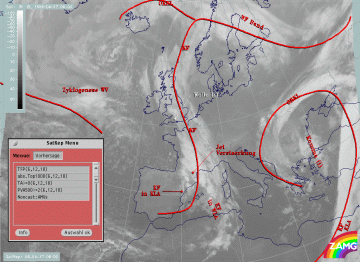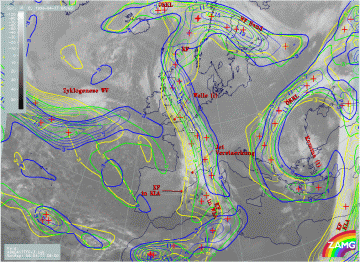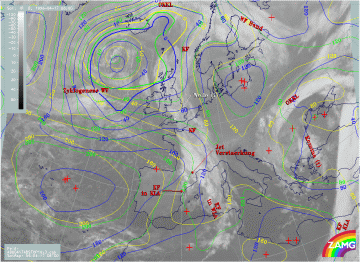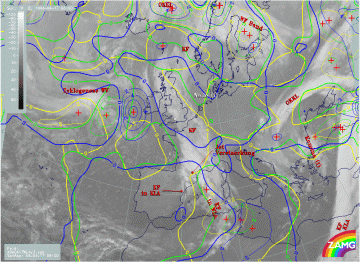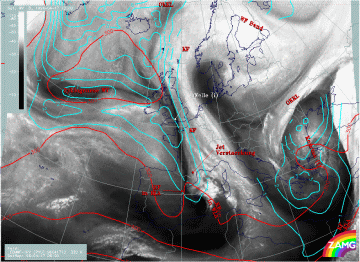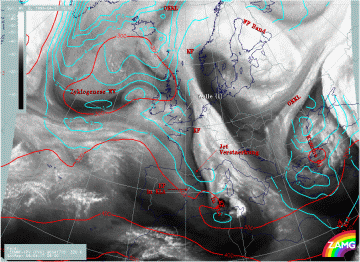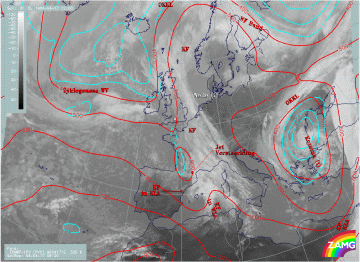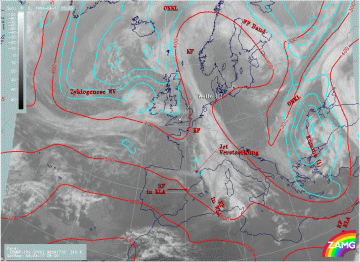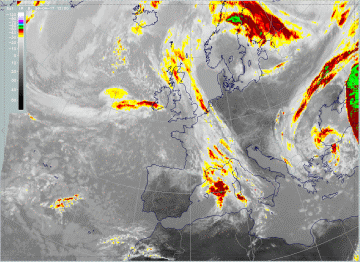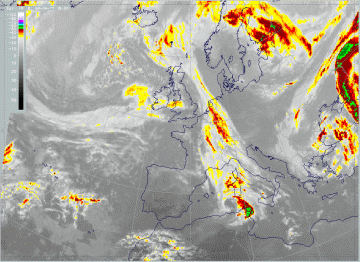17 April 1996 - Forecast For Wave
|
17 April 1996/06.00 UTC - Meteosat IR image; SatRep overlay: names of conceptual models, SatRep menu: key parameters for Wave forecast
|
|
Concerning the forecast of the conceptual model "Wave", in the SatRep Menu a button "Vorhersage" (= forecast) has to be clicked and then the relevant menu appears. As can be seen, two kinds of forecasts and forecast times are presented:
The very short range forecast VSRF (06.00 - 18.00 UTC, 12 hours)
For the very short range forecast, six-hourly forecasts from ECMWF are used and those parameters which are key parameters of a conceptual model are prepared as overlays on the satellite image in three different colours, representing the three points of time 06.00, 12.00 and 18.00 UTC:
- yellow: 06.00 UTC
- green: 12.00 UTC
- blue: 18.00 UTC
In the case of the conceptual model "Wave", the thermal front parameter (TFP), the height contours for 1000 hPa, warm advection (TA>=0) and the maxima of positive vorticity advection (PVA500>=2) are taken into account.
Nowcasting (0-2 hours)
For this forecast time, atmospheric motion vectors (AMVs) are used which extrapolate the cloud systems for the next two hours. These nowcasts are renewed half-hourly or hourly and are not discussed here.
|
17 April 1996/06.00 UTC - Meteosat IR image; yellow: height contours 1000 hPa 06.00 UTC, green: height contours 1000 hPa 12.00 UTC,
blue: height contours 1000 hPa 18.00 UTC; SatRep overlay: names of conceptual models
|
|
|
17 April 1996/06.00 UTC - Meteosat IR image; yellow: height contours 1000 hPa 06.00 UTC, green: height contours 1000 hPa 12.00 UTC,
blue: height contours 1000 hPa 18.00 UTC; SatRep overlay: names of conceptual models
|
17 April 1996/06.00 UTC - Meteosat IR image; yellow: temperature advection - WA 1000 hPa 06.00 UTC, green: temperature advection - WA
1000 hPa 12.00 UTC, blue: temperature advection - WA 1000 hPa 18.00 UTC; SatRep overlay: names of conceptual models
|
|
17 April 1996/06.00 UTC - Meteosat IR image; yellow: positive vorticity advection (PVA) 500 hPa 06.00 UTC, green: positive vorticity
advection (PVA) 500 hPa 12.00 UTC, blue: positive vorticity advection (PVA) 500 hPa 18.00 UTC; SatRep overlay: names of conceptual
models
|
|
All three parameters show the same movement from the central English Channel northward into the North Sea. The PVA maximum remains approximately at the same strength and is centred at 18.00 UTC immediately east of Scotland. The smallest propagation shows the area of WA which is still very weak, in contrast to the possible conclusion drawn from the discussion at 06.00 UTC (compare Wave ) that it could strengthen during the process of cyclogenesis; this cannot be seen in the forecast material.
For this Wave development which does not fit fully into the classical conceptual model because of the deviating behaviour of the temperature advection field, an additional parameter has been taken into account: PV on two isentropic surfaces (compare Wave ). Forecast PV fields can help for decide about further development or decrease of the Wave.
|
17 April 1996/12.00 UTC - Meteosat WV image; cyan: potential vorticity (PV) 320K, red: isobars; SatRep overlay: names of conceptual
models
|
17 April 1996/18.00 UTC - Meteosat WV image; cyan: potential vorticity (PV) 320K, red: isobars; SatRep overlay: names of conceptual
models
|
|
17 April 1996/12.00 UTC - Meteosat WV image; cyan: potential vorticity (PV) 305K, red: isobars; SatRep overlay: names of conceptual
models
|
17 April 1996/18.00 UTC - Meteosat WV image; cyan: potential vorticity (PV) 305K, red: isobars; SatRep overlay: names of conceptual
models
|
The higher level of 320K (upper two images) describes a region approximately in or slightly above the 300 hPa level. For both points of time dry, stratospheric air represented by high PV values can be seen behind the frontal cloud band and coinciding with the black areas in the WV imagery. The lower levels of 305K (12.00 UTC) and 310K (18.00 UTC) still show an area where air mass changes from tropospheric to stratospheric values close to the Wave point and at heights of approximately 400 - 550 hPa, but they do not indicate a further sinking of dry stratospheric air.
Consequently from the PV fields no Rapid Cyclogenesis can be deduced but rather, taking all forecast parameters into account, a slow further development of the Wave. The images below confirm these ideas. The narrowing of the cloud band mentioned before fits well together with the dry air, although an exact forecast of cloud boundaries from this material seems to be rather difficult.
|
17 April 1996/06.00 UTC - Meteosat IR enhanced image
|
17 April 1996/12.00 UTC - Meteosat IR enhanced image
|
|
17 April 1996/18.00 UTC - Meteosat IR enhanced image
|
|
